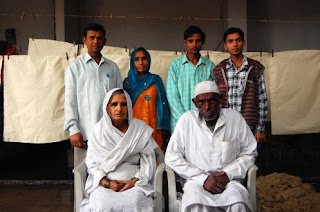Man with the ‘Box Camera’
Tikam Chand is no ordinary photgrapher, his camera makes him distinct from others.
Riding on his rusty bicycle, he navigates past a group of pedestrians in chaos of old Jaipur and finally reaches his open air studio near City Palace. Immediately after arriving, he unties his prized possession a 20-kg ‘Box Camera’ that took its first photograph sometime around 1865. Ever since then, the camera has obediently followed the orders of its subsequent owners, first Tikam Chand’s grandfather, then his father and now himself.
 As he talks to us, his first customer has arrived. 45-year-old Jatin Kumar, a daily wage laborer needs a passport size photograph for some court work. He will pay only Rs 50 to get his four B&W photographs clicked and printed in just 5 minutes.
As he talks to us, his first customer has arrived. 45-year-old Jatin Kumar, a daily wage laborer needs a passport size photograph for some court work. He will pay only Rs 50 to get his four B&W photographs clicked and printed in just 5 minutes.
“Technology has made us lazy, taking photographs used to be an art. Now the thinking has disappeared and all they do is click,” 42-year-old photographer explains. “Digital cameras can never give you such joy,” he adds.Clicking a photograph with this ancient camera looks so interesting you can just stand there and watch him as he starts his work. How he adjusts the camera’s focus by sliding the ancient Carl Zeiss lens back and forth along a track before ducking beneath a large piece of cloth at the back to slide the photo paper behind a glass plate.





 The shutter release button has been an integral part of camera for long is nowhere to be seen here. Tikam Chand just removes the lens cap for one or two seconds to expose the photo paper to make an image. Then he comes back under the coverings, sticking his hand in tubes made of a blue jeans leg to shift the paper from developing chemicals into the fixer, then into a plastic bucket to rinse off the chemicals.
The shutter release button has been an integral part of camera for long is nowhere to be seen here. Tikam Chand just removes the lens cap for one or two seconds to expose the photo paper to make an image. Then he comes back under the coverings, sticking his hand in tubes made of a blue jeans leg to shift the paper from developing chemicals into the fixer, then into a plastic bucket to rinse off the chemicals.The image made after all this will dampen you spirits, its just a negative image and he will have to shoot this negative to make it positive by going over the same process once again.
His clientele includes locals as well as tourists from Russia and Thailand. He’s out here every day, shouting, calling tourists to get their photos clicked. On a bad day he’ll earn nothing, on a good day it’s up to Rs 500.
The story of this box camera and how his family got it has almost become a part of the forgotten past now. All he knows is that, his grandfather somehow received the camera as a gift from the royal family. For the last three decades, this camera has been the sole bread earner for him, his wife and two sons.Will either of his sons, aged 6 and 11, go into this business? “They only like the new stuff, cell phones and computer games etc.” he says. “I guess it will probably end with me.”


























